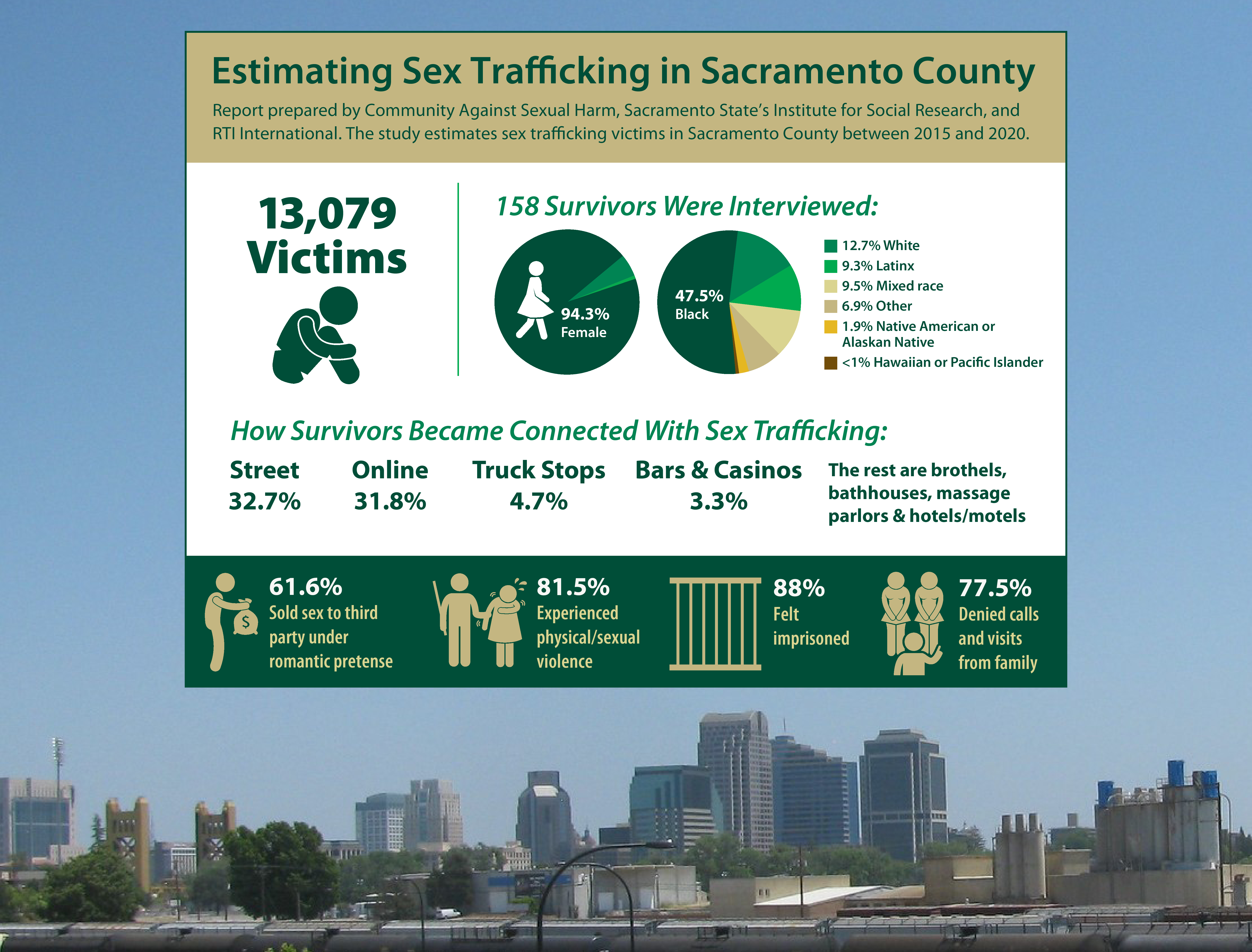Story Content
Sac State’s Institute for Social Research helps document alarming level of sex trafficking in Sacramento County

July 21, 2022
Sacramento State’s Institute for Social Research (ISR) played a key role in a newly released study that for the first time documents the disturbing scope and nature of sex trafficking in Sacramento County.
The report, released Wednesday, July 20, estimates more than 13,000 people were victims of sex trafficking in Sacramento County at some point between 2015 and 2020.
“It’s an astonishing number,” said Shannon Williams, ISR executive director The research institute conducted a separate poll that found more than 70% of county residents know little or nothing about sex trafficking in the area.
ISR worked with a local nonprofit group, Community Against Sexual Harm (CASH), and a nonprofit research organization, RTI International, on the project. Sacramento Mayor Pro Tem Eric Guerra helped secure $1.5 million in state funding for the project.
In addition to collecting data, researchers interviewed 158 people who had been sexually trafficked. The surveys revealed critical details about sex trafficking, including strategies used to recruit and control victims.
Results of the study will help the county address a crime that occurs in the shadows, with some of its victims as young as 14, officials said.
“No one really knows the parameters of this (sex trafficked) population,” Williams said.
The information gathered could be used to help other entities document sex trafficking in their communities, aid law enforcement, and design services for survivors, researchers said.
Sex trafficking, which is defined as trading anything of value for a sex act through the use of force or coercion, is a federal crime. It has been reported in all 50 states, but little reliable data exists about its prevalence.
ISR collected data about sex trafficking from nine different agencies and institutions in Sacramento County, including police departments, hospitals, nonprofit groups and others. RTI International then used the data to estimate the prevalence of sex trafficking in the county. CASH established an advisory council of commercial sexual exploitation survivors, who helped design a questionnaire and interviewed other victims about their experiences.
Based on data collected locally, RTI International estimates 13,079 adults and minors were victims of sex trafficking in Sacramento County at some point between 2015 and 2020, more than 11 times the number identified by law enforcement and service providers.
“It’s very important that we know the true scope of this problem,” said Terri Galvan, CASH executive director, whose agency offers services annually to about 300 adults who have been commercially sexually exploited. “These are our students, our daughters, our sons, our mothers,” Galvan said. Most of the people CASH serves were recruited into trafficking when they were young teenagers, she added.
“We need to educate people, and drive financial support for survivors,” many of whom have been psychologically and physically wounded by their experiences, she said. “The hope is that we will be able to do more in a smarter way” to help victims escape and thrive.
Many victims of sex trafficking fear trying to break away from their exploiters, who may threaten them with injury or other consequences for leaving, said Galvan.
Asked about the types of exploitation they suffered, many women said they started working for a “third party” involuntarily, felt trapped, experienced physical or sexual violence, and had their phones, driver’s licenses, and other identification confiscated by their abusers. Some said they became involved in sex trafficking after developing a romantic attachment to their traffickers.
“A lot of the victims are first trafficked as teenagers, and people who are vulnerable are intentionally targeted,” Williams said. “Some are former foster kids who have nowhere to go” after aging out of the system.
“The issue is so much more complex than it has been depicted.”
Study participants said they most often found sex work on the street, online, at truck stops, and at bars and casinos. Victims often were transported out of the county, the report shows.
“I ended up in Fresno at his house with a lot of other girls.” one victim told her interviewer. “He said the only way for me to go home was to make money” selling sex. “I never, like, even thought to do something like that.”
Others described beatings and other violence inflicted by their traffickers.
“I left once … when he caught me … it was bad. I was going to die, you know … he was slapping my face with a pistol,” one woman told interviewers.
Another woman who escaped the streets said she lives in fear of her former trafficker.
“I knew from that moment I could never be around this man again, because he is going to kill me eventually,” she said. “He wants to, and if I make him mad enough, he will.”
Researchers called for adopting a public health approach to the issue, improving access to housing and employment, and expanding counseling and other programs for survivors. Williams said ISR will keep working with CASH to evaluate the effectiveness of services.
“This is happening in our communities, where we live, where we work, where we shop,” Guerra said. Understanding “a dark side of our county” will allow agencies to develop a more effective response and “help victims escape and rebuild their lives,” he said.Media Resources
Faculty/Staff Resources
Looking for a Faculty Expert?
Contact University Communications
(916) 217-8366
communications@csus.edu


